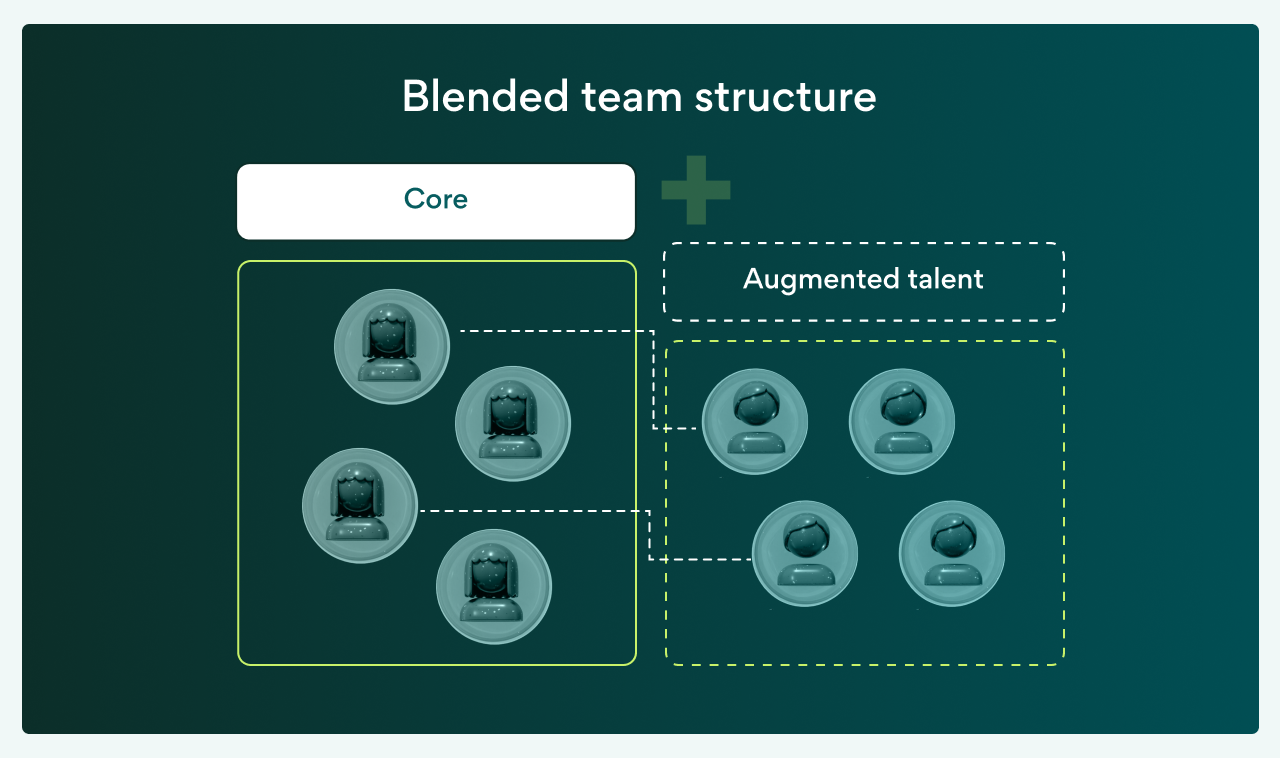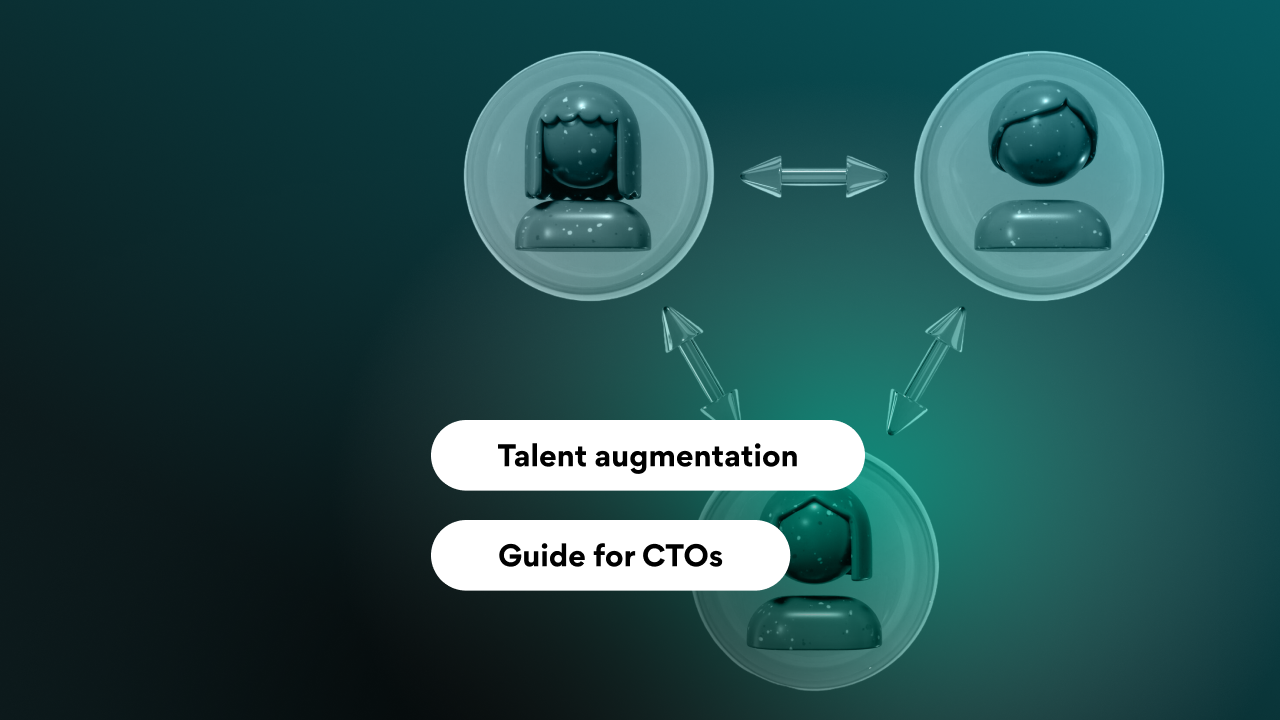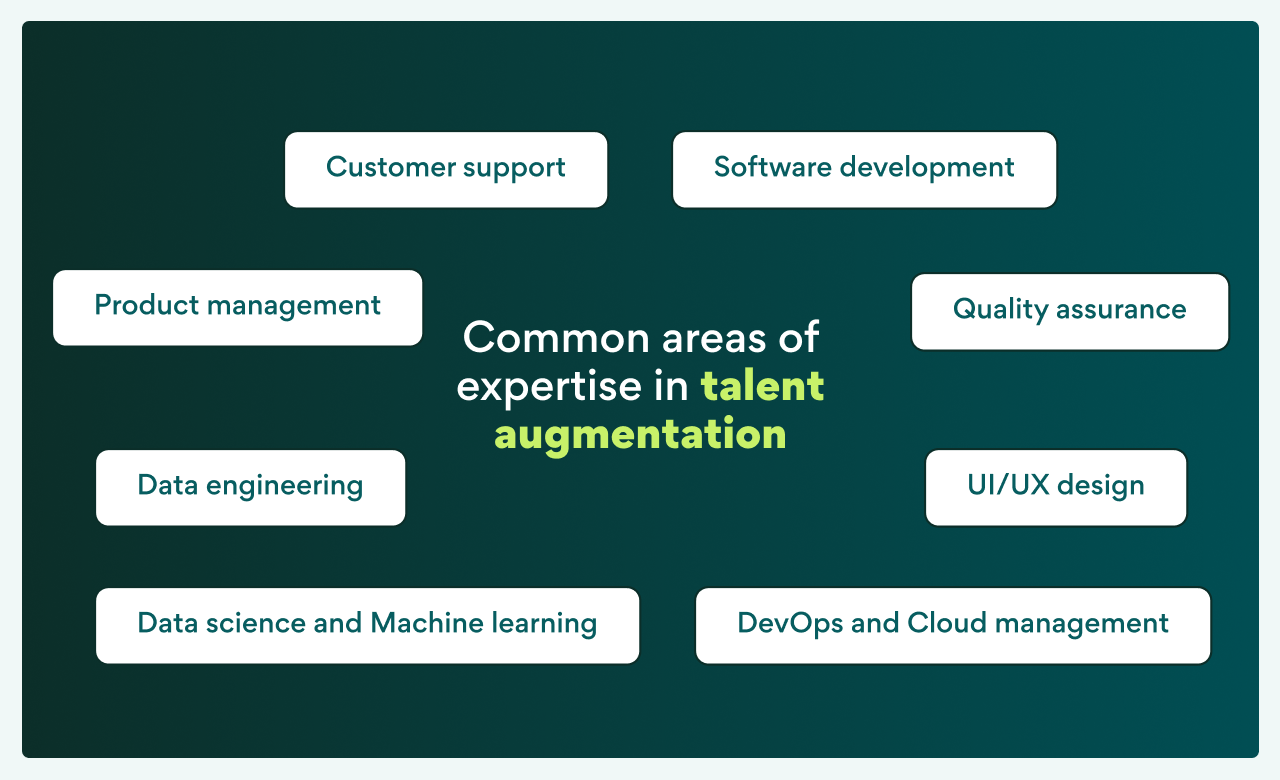



Talent augmentation or staff augmentation is a flexible workforce strategy that involves bringing in external professionals to supplement an existing team’s capabilities. Unlike traditional hiring, it allows companies to quickly access specialized skills or scale up resources without long-term commitments.

In the tech context, talent augmentation might involve hiring freelance developers, product designers, data scientists, or DevOps specialists to accelerate delivery, fill skill gaps, or support high-priority initiatives. These professionals typically integrate with internal teams and workflows, working as an extension of your in-house staff.
The key advantage is agility: companies can respond to changing needs without the overhead of in-house hiring or the disconnect of fully outsourced solutions.
Traditional hiring doesn’t always keep pace with shifting product demands, evolving technologies, and the pressure to deliver quickly. That’s where talent augmentation can help.
This guide breaks down what talent augmentation is, how it compares to other models, and how CTOs and founders can use it strategically to build leaner, faster, and more adaptive teams.
For CTOs and founders, talent augmentation offers a way to align technical execution with business agility. As product cycles shorten and competition increases, the ability to quickly access the right skills becomes a key differentiator.
Tech leaders often face challenges such as talent shortages, sudden spikes in workload, or the need for niche expertise that isn’t available in-house. Talent augmentation addresses these gaps by providing on-demand access to professionals who can contribute immediately.
It also supports lean team structures, enabling companies to stay focused on core competencies while flexibly scaling around changing priorities. Instead of overhiring or risking under-resourcing, leaders can make smarter, more adaptive decisions about team composition, keeping velocity high without compromising quality.

Traditional hiring doesn’t always keep pace with shifting product demands, evolving technologies, and the pressure to deliver quickly. That’s where talent augmentation can help.
This guide breaks down what talent augmentation is, how it compares to other models, and how CTOs and founders can use it strategically to build leaner, faster, and more adaptive teams.
Talent augmentation or staff augmentation is a flexible workforce strategy that involves bringing in external professionals to supplement an existing team’s capabilities. Unlike traditional hiring, it allows companies to quickly access specialized skills or scale up resources without long-term commitments.

In the tech context, talent augmentation might involve hiring freelance developers, product designers, data scientists, or DevOps specialists to accelerate delivery, fill skill gaps, or support high-priority initiatives. These professionals typically integrate with internal teams and workflows, working as an extension of your in-house staff.
The key advantage is agility: companies can respond to changing needs without the overhead of in-house hiring or the disconnect of fully outsourced solutions.
For CTOs and founders, talent augmentation offers a way to align technical execution with business agility. As product cycles shorten and competition increases, the ability to quickly access the right skills becomes a key differentiator.
Tech leaders often face challenges such as talent shortages, sudden spikes in workload, or the need for niche expertise that isn’t available in-house. Talent augmentation addresses these gaps by providing on-demand access to professionals who can contribute immediately.
It also supports lean team structures, enabling companies to stay focused on core competencies while flexibly scaling around changing priorities. Instead of overhiring or risking under-resourcing, leaders can make smarter, more adaptive decisions about team composition, keeping velocity high without compromising quality.
Talent augmentation is most valuable when your in-house team lacks the time, capacity, or specific expertise needed to meet business goals. Here are common scenarios where talent augmentation makes strategic sense:
Startups and scaleups often keep their core team small and flexible. Talent augmentation lets them expand efficiently by hiring in more cost-competitive regions, where salaries and taxes are lower.
In each of these cases, augmentation helps tech leaders stay focused on outcomes, not headcount, giving teams the flexibility to adapt without compromising execution.
There are several ways to implement talent augmentation, depending on your project needs, budget, and team structure. Below are the most common models tech leaders use:
Each model has trade-offs in terms of control, cost, speed, and integration. The right choice depends on your technical goals, internal capacity, and tolerance for coordination overhead.
Selecting the right talent augmentation partner or platform is critical to ensuring quality, speed, and alignment with your team’s goals. Here’s what to consider:
Choosing the talent augmentation company is not just about filling a gap. It's about finding someone who can contribute meaningfully and fit seamlessly into your workflow.
Talent augmentation can deliver significant benefits, but it’s not without risks. One common issue is poor onboarding. Even skilled external professionals will struggle without context, clear documentation, or access to the right tools. Skipping this step can lead to delays, misalignment, and frustration on both sides. Avoid this by treating onboarding as a core part of the engagement, even for short-term contributors.
Another pitfall is lack of ownership. If expectations aren’t clearly defined, augmented talent may hesitate to take initiative—or worse, go in the wrong direction. Make sure roles, responsibilities, and deliverables are agreed upon early and reviewed regularly.
Communication gaps are also a frequent source of problems. Time zone differences, unclear feedback loops, or missing documentation can lead to rework or stalled progress. To prevent this, ensure regular check-ins and consistent inclusion in relevant team discussions.
Finally, there’s the risk of over-reliance. While talent augmentation can be powerful, it's not a substitute for strong internal capacity and long-term planning. Use it to complement your core team, not replace it. Always think ahead about how knowledge will be transferred when the engagement ends.
Many tech companies from early-stage startups to global enterprises have used talent augmentation to solve complex problems, accelerate delivery, and remain agile without overextending internal teams.
A well-known example is Slack, which, during its early growth phase, brought in contract developers to help build out key features while the core team focused on product stability and user experience. This allowed them to move quickly without sacrificing quality or control.
Spotify has also used external consultants and freelancers to support its engineering teams during platform migrations and to prototype new tools. These specialists worked alongside in-house developers, contributing to short-term objectives without adding permanent headcount.
Even larger companies like Microsoft and IBM regularly augment teams through external partnerships, particularly for R&D, cybersecurity, and cloud infrastructure projects where specialized skills are essential but not always needed long-term.
As technology and business needs evolve, talent augmentation is shifting from a tactical solution to a core component of workforce strategy. One major trend is the rise of AI-powered platforms that streamline the process of sourcing, vetting, and managing augmented talent. These tools are reducing time-to-hire and improving fit by matching specific skills with project needs more precisely than traditional methods.
Another shift is the growing demand for highly specialized expertise, particularly in areas like AI, cybersecurity, and cloud infrastructure. As these skills become harder to find and more expensive to retain full-time, companies are turning to augmentation as a way to access top-tier talent on demand.
Organizations are also blending human and automated capabilities in their teams, creating hybrid models where external experts work alongside AI-driven systems. This approach boosts efficiency while maintaining a high level of quality. At the same time, there’s an increased focus on integrating augmented professionals into the broader team culture, ensuring they contribute effectively and feel like part of the team—even if only temporarily.

Looking ahead, companies are expected to invest more in upskilling internal staff while using augmentation to fill immediate or specialized gaps. This dual strategy helps build long-term resilience while maintaining short-term agility.
Partnering with the right talent augmentation company can make the difference between a reactive hiring strategy and a proactive, growth-oriented team structure. With ALLSTARSIT, tech leaders gain access to a curated network of top-tier engineers, developers, and specialists who are carefully matched to your needs and integrated seamlessly into your workflows.
Unlike traditional staffing firms, ALLSTARSIT focuses on long-term alignment, not just filling roles. Whether you're launching a new product, expanding into new markets, or accelerating delivery cycles, their approach allows you to scale up or down quickly without compromising on quality or culture fit.
What sets ALLSTARSIT apart is its commitment to engineering excellence, operational transparency, and true partnership. You maintain full control over your roadmap and team direction, while ALLSTARSIT handles the complexities of sourcing, compliance, and ongoing support. The result: a more agile, resilient tech team capable of adapting to evolving business demands without the overhead of traditional hiring.
Ready to scale smarter? Explore how ALLSTARSIT can help you build a high-performing, cost-efficient tech team. Get in touch to find the right talent, faster.
Traditional hiring doesn’t always keep pace with shifting product demands, evolving technologies, and the pressure to deliver quickly. That’s where talent augmentation can help.
This guide breaks down what talent augmentation is, how it compares to other models, and how CTOs and founders can use it strategically to build leaner, faster, and more adaptive teams.